Three unrelated events had the effect of catapulting me back 41 years. Several months ago I bought a Rubik’s Cube as part of a musical experiment. Two separate Facebook friends posted links to songs from South Carolina’s Tricentennial, and this week I met with my friend Tim Taylor about setting up a geocaching trail around the Roper Mountain Science Center. Those three events together created a time warp, and sent me in search of information about Greenville’s ill-fated Piedmont Exposition Park, and the geodesic cube designed by Buckminster Fuller that was supposed to sit atop Roper Mountain.
It was the 1969-1970 school year, and I was in Mrs. Medlock’s third grade class at Gray Court-Owings School. In third grade the social studies curriculum is all about South Carolina, so the timing with the state’s tricentennial was perfect. We all sang that we were good Sandlappers, and we learned about the various sections of the of the state, from the coastal plains to the Piedmont.
A 300 year celebration was a really, really big deal, not just for our class, but for the entire state. Then Governor Robert McNair established the Tricentennial Commission, which put together the master plan for the celebration. We had just finished the tumultuous sixties, and the state was moving forward, and that seemed to permeate the planning and celebrations. I still attended a segregated school, but that would change the following year. Greenville was tearing down vintage buildings such as the old city hall and Woodside Building and replacing them with steel and concrete marvels. It was only right that the Tricentennial Commission should also look forward, as well as reflecting on the past.
So, in that vein, three Tricentennial Exposition Parks were planned. First, the Charles Towne Landing Exposition Park would be located at the first settlement of the colony, and would focus on the first hundred years and colonial life in the states.
The Midlands Exposition Park would be located in Columbia, and would incorporate the historic Hampton-Preston and Ainsley Hall Mansion. This center would focus on the second hundred years, from the American Revolution to just after the Civil War.
Finally, there was the Piedmont Exposition Park, to be located on Roper Mountain just outside of Greenville. This would focus on the last hundred years, and feature the growth of manufacturing in the state.
The architecture for each park was to be stunning and unique. Since this was a “Tri”-centennial, triangles, or at least polyhedra based on triangles, were incorporated into the architecture as much as possible. As seen in the above artist’s renderings, the Charles Towne Park would have a huge open air pavilion, the Columbia Park would sport twin geodesic domes to house their exhibitions. Greenville would have the most daring of all – a geodesic structure designed by Buckminster Fuller himself.
According to the final report of the Tricentennial Commission…
During the summer of 1968, internationally famous designer, Dr. R. Buckminster Fuller arrived in Greenville to examine the site for the proposed center. The concept which had been considered by the Commission staff was a Fuller half dome which would cover a 300′ diameter area on the south side of Roper Mountain….The local Greenville architects associated with Dr. Fuller suggested a new approach to the use of the Fuller geodesic frame and requested that Dr. Fuller consider the possibility of a rectangular structure. From this, the concept of the “Tetron” a cube standing on one point, developed.
The design for Greenville’s center called for a five-level open air structure. Protection from the elements would come from the cube itself, which would mean a massive enclosed space. The cube would be situated point down, as if one of its corners were embedded in the mountain.
From the outset there were problems with construction and delays, not just with the Roper Mountain project, but with the other two parks, as well. The Tricentennial Commission reported as follows:
In March 1970, the same structural difficulties that showed in the roof-grid in the Charleston pavilion caused a halt in the construction of the Piedmont structure. Due to complexities of this building it was impossible to reach a temporary solution such as was arrived at in the Charleston structure.
It became apparent that the cube could not be completed and enclosed in time for the anticipated opening. Reluctantly, the inner building itself was enclosed so that environmental controls could be added.
With continued cost overruns, construction delays, and design problems, the future of the Tetron was in doubt. However, it was nature that dealt the final blow, or, at least, revealed the fatal flaws that sealed its doom.
The grand opening was scheduled for the July 4th weekend of 1970. The park opened to selected VIPs on Friday, July 3, with Senator and Mrs. Strom Thurmond and other dignitaries in attendance.
The day started well, but later that afternoon a severe thunderstorm came up with heavy lightening, wind and rain. The lower levels of the building completely flooded, causing extensive damage to center.
Although a fireworks display had been scheduled to climax the evening, the natural display of lightening, wind, and rainstorm which occurred during the preview eclipsed any man-made entertainment, and kept the staff up around the clock repairing damage before the July 4th opening for the public the next day.
Even with the damage, the park was open Saturday, July 4, and the rest of the ceremonies proceeded on schedule. The park was open for several more weeks and some events were held there. Ultimately, though, the design flaws were insurmountable, and the center closed. In January of 1971, newly elected Governor John West put a hold on any further construction on the site.
I had followed the saga of the Tetron very closely. Even as a child I was fascinated by the weird architecture, and I really wanted to visit. Unfortunately, we were never able to do so. The closest we got was when Dad drove us up for one of the ceremonies. It was too crowded to actually enter the site. We drove down Woodruff Road, which back then seemed like the middle of nowhere, and parked just off of the I-385 overpass in what would now be the Ruth Chris’ parking lot. We paused to watch a hot air balloon launch from the lower parking lot of Roper Mountain, then headed back home. Eventually, I was able to visit the Charles Towne Landing Park, but I have very few memories of it. I never visited the Midlands Park.
In late 1971 the Tricentennial Commission issued its final report. Even that late, the report expressed the hope that the site could be completed as planned. The Commission released all of its remaining funds to the South Carolina Parks and Recreation Commission so that the building could be finished.
Alas, it was not to be. The site sat abandoned, and the land was eventually purchased by the Greenville County School District in 1974. The Horticultural Center opened, but the original exposition building sat empty for 12 years.
In 1985, the Roper Mountain Science Center officially opened with the Horticulture Center, and in 1986 a master plan was developed. The original intent was to finish the main building, to house the science center, planetarium, and observatory. However, the old building was torn down, and the current facilities were constructed.
I would have loved to have seen the Tetron completed, but the existing facilities on Roper Mountain are excellent, and have been a great asset to the community. On my recent visit, Tim took me on a tour of the Natural Sciences building, and I was amazed at the new construction, which included water environments and a rain forest. Still, it would have been interesting to see the huge structure looming over I-385. Here’s the current site from Google Earth…
…and here’s what it might have looked like with the cube…
But what of the other two Tricentennial Parks? Part of the problem was that the pavilion structures were inconsistent with the settings. In Columbia you had two ultra-modern domes flanking a colonial mansion.
The domes were eventually removed, and the mansion is now operated as part of the Historic Columbia Foundation.
In Charleston it was even worse. The ultra-modern buildings were completely out of keeping with the original landing site. It was almost the way some Parisians feel about the pyramid in front of the Louvre.
Even worse, the pavilion and associated buildings disrupted Native American burial sites. According to a redevelopment case study,
While the focus of research was on the past, the design of the park emphasized the future. The architecture of new park facilities, especially the interpretive center called the Exhibit Pavilion, was described as €œultra-modern€ in design. The Pavilion, which covered an acre of ground, quickly became the focal point of the park and an icon to local residents. The construction of this facility almost completely destroyed the Native American ceremonial center and its associated burials. Planners were careful not to locate the new facilities within the known 1670 fortifications, but in doing so they sacrificed a very significant Native American site.
The pavilion, which was already in bad shape from damage during construction, was dealt a final blow in 1989 when Hurricane Hugo came through. However, the geodesic structures were left in place for another 13 years. Finally, between 2003 and 2005, the old Tricentennial structures were removed, and a serious archeological study of the site was begun. A new interpretive center has been built, more in keeping with the surroundings.
So, it appears that the ultra-modern geodesic structures weren’t the way to go, after all. Every one of them was eventually demolished, and the one on Roper Mountain was never completed. I hope that the Quadcentennial planners do a better job. Yes, we like cool buildings, but we also like something that is in keeping with the environment and that is sensitive to the context. Of course, by that time, and given our budget-cutting government, we’ll be lucky to have a potting shed.
Bibliography:
I’ve got to say – it was hard tracking down information on these sites. There was little or nothing on the Internet. I guess folks don’t really want to remember a $10 million dollar boondoogle. That, plus the fact that it was 40 years ago. Even so, I was able to find a few things…
Books:
- South Carolina tricentennial scrapbook – Whiting, Jan. – basically a notebook in the South Carolina room of the Greenville County with brochures and other ephemera from the event.
- Report of the South Carolina Tricentennial Commission – South Carolina Tricentennial Commission, 1971.
- South Carolina architecture, 1670-1970 – McClure, Harlan Ewart, 1970.
- Greenville News – July 3 & 4, 1971, March 1986.
Online:
- Charles Towne Landing State Historic Site – Redevelopment Case Study – National Park Service, 2006 (MS-Word Format)
- Stanford University Online Archives of Buckminster Fuller
- Historic Columbia Foundation
- Roper Mountain Science Center
- …and finally, information about the Singing Sandlappers from the Columbia Closings Blog.
UPDATE: A Reddit user posted a thread on the /RetroFuturism subReddit about the Greenville Tetron. That thread included some design images of the Tetron that I’d not seen. I’ve included them below:
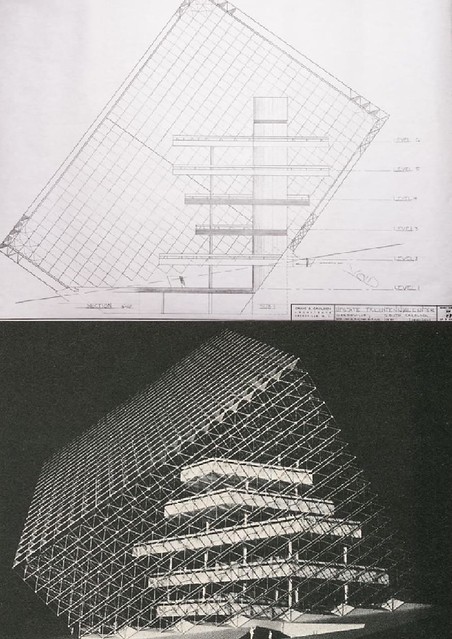
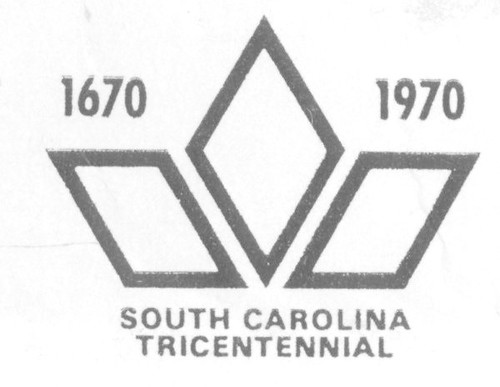
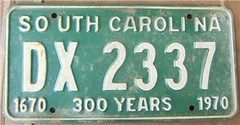
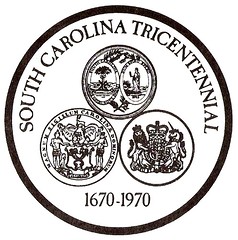
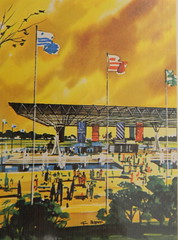
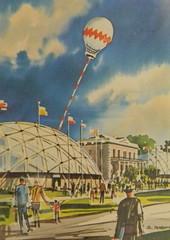
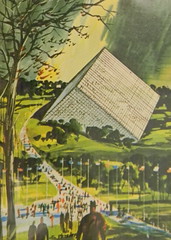
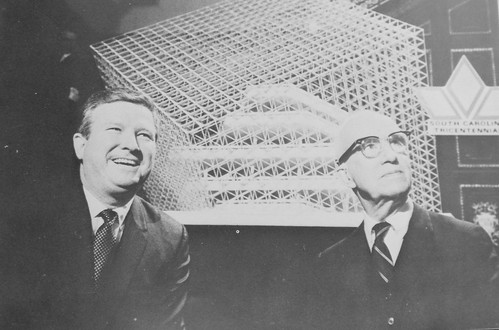
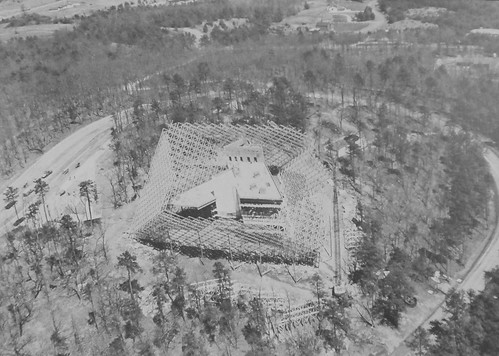
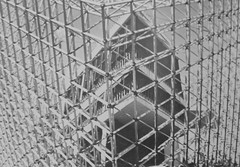
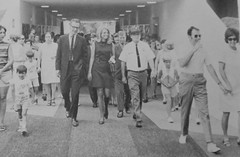
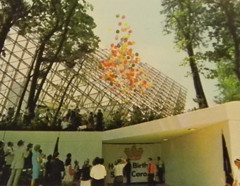
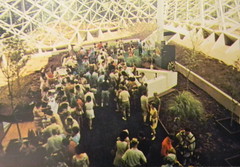
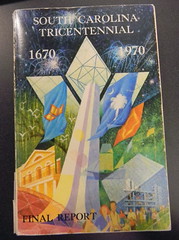
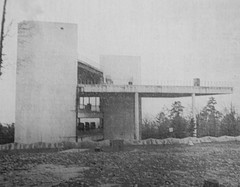
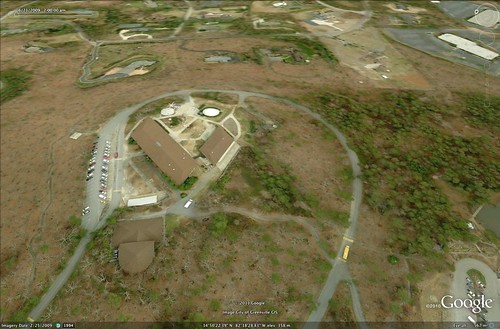
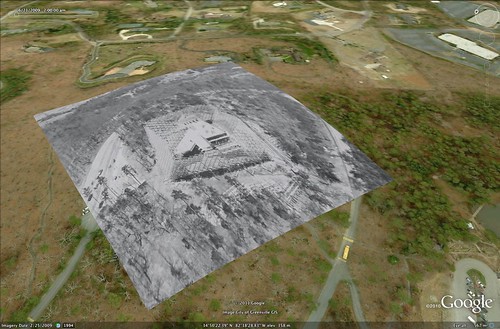
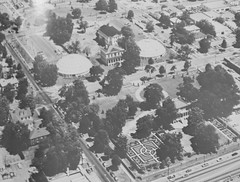
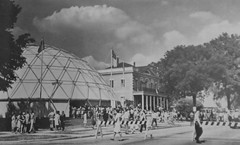
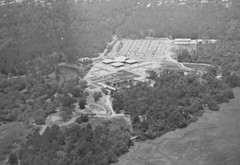
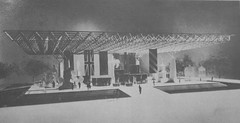
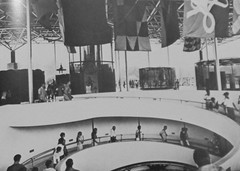
Thanks for the history lesson. I wasn’t aware of any of this!
Since you and I are the same age, I remember this, too. Living in Charleston, we were excited about Charlestowne Landing and our Girl Scout troop even did a play at the pavilion during the opening of Charlestowne landing. I liked the pavilion and its historic displays, but the geodesic dome always seemed out of place. I have been to Charlestowne Landing since those two structures have been removed, and it is much more natural and historic without those two jarring architectural anachronisms.
Thank you! That clears up the mystery of that mysterious white building on Roper Mountain I remember from way back. A related story but with more info about the songs:
Tricentennial Songs, Columbia & Everywhere in South Carolina: 1970
I even remember hearing part of the “Sandlappers” song played over and over on ETV when I was a kid. Poor kid 🙁
TC Howard of Synergetics, Inc designed all three sites , not Buckminster Fuller. And the two domes were Charter-Sphere Domes, not geodesic domes. The Tetron was flawed from the start and was never completed due to the manufacturing flaws. –
Thanks for the clarification. My comments were based on information provided in what I could find at the Greenville County Library.
I was lucky enough to visit all three sites during the time of the celebrations. I remember my dad saying that the cube on Roper Mountain could not be completed because the sheer weight of the material would have caused the structure to collapse. Looked good on paper, but there was no way to get a small corner of the cube to handle the entire weight of the structure.
We used to visit Charles Townes Landing every summer and I remember after Hurricane Hugo, the underground museum was buried by the surge of mud and debris left by the storm. We were told there were no plans to reopen the museum, but I’m curious to know if that changed.
I think I may have photos or slides from our visits to the parks if you are interested.
I went to Eastside High School in Taylors. After the site was closed, my friends and I would sneak around the fencing (in our cars) and drive up to the closed building. We scaled up to the second floor windows, and found one open. We spent a year or two having parties inside the condemned building. Power was still on, and we had lights. All of us would meet up there on weekends, enter the building and party away all night. Never got caught. There were conveyor belts with textile items that would rotate around the ceiling, and we would latch on and ride around!
What a teenage memory!
I appreciate you writing this up. I was looking for information on the geodesic cube in Greenville. I’m quite close by at the moment, revisiting the area after very many years.
I remember the dome. We visited when I was a kid, and I remember that the construction could not be completed in time for the exposition. It still looked quite neat, and I was hoping to see it completed some day.
Now I back, and was unable to see any hint of it sticking up over the tree line. I was glad to find your writeup confirming it was demolished. Still sad though. It was a great looking design.
This article was just posted on a related FB page. Very interesting. I had no idea about the three sites. Living in Columbia my school class went to the Hampton-Preston Mansion and I remember the domes. As a volunteer docent now for Historic Columbia I always explain about them and our Tricentennial Celebrations when our visitors see the pictures.
In 1970 I was in the Navy and just docked at the yard. Looking for something to do I drove around ending up at the Charlestowne Landing where the big open-air museum was. An older fellow in a suit walked up to me and began chatting. I was not in uniform. we talked about twenty minutes. Not long after I discovered the man was Mendel Rivers and was at the podium giving a dedication speech. I had no idea this was a special day, a special place, or that I was speaking to a special man. I have since tried to find out where this all was but, as you say, there is scant information available. Thanks for posting.
Thanks for the article and all the comments. That mountain and whatever was going on up there back then was always a mystery to me. “Bucky” Fuller was a genius (heard him speak in person a few times), but it’s a shame that the execution of this project fell apart. Lots of finger-pointing, I’d guess. Still mysterious.
Thank you so much for this! I have been trying to find photos , inside & out, of the Charlestown Landing Exhibit Pavilion for a few decades. That was one of my very happiest places to be when I was growing up. It’s been down right impossible to find pictures. I was devestated to see that Hugo ruined it. I loved all of the history inside, especially those plexiglass tubes that you could stand under to listen to the native American music. Great times. Thanks again!